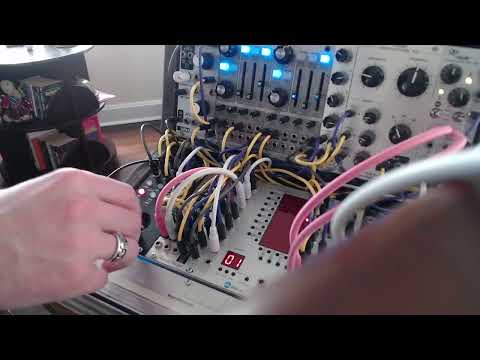2ΔV (Two Delta Voltage)
Two low pass gates, each controlled by the rate of change, rather than the level of incoming voltages.
Signals sent to the Left and Right inputs will be processed by individual low pass gates. Each gate is opened and closed based on the speed of the signals sent to the A and B inputs so, the faster a control voltage is moving, the louder and brighter the output will be. The speed detectors can be used on their own to derive the speed scalar of LFO’s, envelopes, or any moving voltage in your system.
This patch was originally created as a way to mimic the behavior of a bowed string instrument. The bow, or control voltage, must be moving in order to produce sound. The faster the motion, the more intense the sound.
Controls
-
Knob/CV A: LPG Channel A Control
Low pass gate control for channel A. The speed of the signal present at CV A, and of Knob A’s rotation, will be measured and the result will open the LPG. The value of the knob is added to the incoming CV, so adjust its position according to the polarity and level of the signal you are measuring the speed of. If the incoming signal is bipolar, position the knob at 12 o’clock so that the voltage is sweeping across the entire available input range. If it is unipolar, position the knob at its lowest position. -
Knob/CV B: LPG Channel B Control
-
Knob/CV C: Channel A Sensitivity
The speed of each channel’s control input is calculated by comparing a delayed copy of the input signal to its current state. The sensitivity control determines the duration of this delay. At its lowest sensitivity, the delay will be 5ms long and the low pass gate will be able to track very fast moving signals with almost no innate decay. At its highest sensitivity, the delay will be 1000ms long and the LPG will be able to track slow moving signals with a noticeable decay. Certain sensitivity settings work better with certain speeds, so experiment with adjusting this control to suit the signals you’re working with. -
Knob/CV D: Channel B Sensitivity
-
Button/Gate 1: Channel A Mode
Toggles between the default low pass gate behavior and VCA behavior for channel A. -
Button/Gate 2: Channel B Mode
-
CV Out 1: Channel A Speed
This will output the speed scalar of the signal present at CV A to use throughout your system. Even without using the LPG functions of the patch, this output can be used to derive new functions from moving voltages. It’s also useful for self patching. -
By patching one channel’s speed output into the other channel’s control input, you can output a signal proportional to the acceleration of the incoming control signal. This will have its own unique qualities when compared with the speed output.
-
CV Out 2: Channel B Speed
-
Left Input: Input for LPG channel A
-
Right Input: Input for LPG channel B
-
Left Output: Output for LPG channel A
-
Right Output: Output for LPG channel B
Patch Ideas
Bowed Instrument Controller
This works especially well with a joystick, but a Theremin antenna or basic slider or ribbon controller would also work. Patch the X CV from the joystick into CV A, and the Y CV into CV C. The speed of motion on the X axis will open the low pass gate, and the position on the Y axis will control the gate sensitivity, allowing you to intuitively switch between short, fast sweeps and long, slow ones.
Modulation Frequency Doubler/Quadrupler
Patch a cyclic modulator into the A input. The outgoing speed scalar will have two cycles for every one cycle of the modulator, one as the modulator ascends in voltage, the other as it descends. Then, patch CV Out 1 into the CV B input. The second channel will cycle twice for every cycle of the first channel’s output. This can be a simple way to produce a cluster of modulators that are all tied together and controllable from a single source.
Amplitude Echo
By patching a channel’s speed scalar into its own control input, you can create a decaying echo in the signal. When used for amplitude control, this can sound like a delay with feedback.
Speed-Based Compressor
Plug an envelope follower into a CV input and use the resulting speed scalar to compress another signal. This can sound especially interesting when used in tandem with the original envelope’s compression. Use the envelope follower to perform standard side-chain compression on a bass sound, while the 2ΔV signal compresses some other part of the mix. The secondary compressor will lag behind the first and have a more complex shape that reacts to the amount of initial compression.
Feedback Chaos
When patched as part of a feedback loop, the speed CV signal will react differently than a typical amplitude signal. Patch an LFO to CV A, and send CV Out 1 back to the LFO’s frequency input and experiment with how they interact. This can be made more complex by patching another signal to control the sensitivity at the same time.
Event Detector
Speed detection is not a common tool in a modular system, so this patch can offer some unique utility. For example, by sending a clocked random signal or a sequence to 2ΔV, you can produce a signal that will only rise when the voltage is jumping by a particularly wide gap in values. This could be used to trigger events only when you make a jump in octaves while playing, or to get more variety out of a generative patch.
